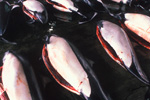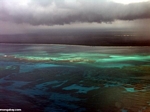The New Zealand Ministry of Fisheries estimates that from 2007-2008, 273 New Zealand fur seals (Arctocephalus forsteri) were killed by offshore trawling hoki fisheries, an increase of over 75 seals since the previous year. New Zealand’s hoki fishery has been certified as sustainable by the Marine Stewardship Council since 2001 and re-certified in 2007. Hoki is commonly used for ubiquitous fried fish sandwiches, such as those served at McDonald’s.
“The research report shows that certification under the Marine Stewardship Council has not prevented large numbers of fur seals from being killed in the hoki fishery,” says Kirstie Knowles of local conservation organization, Forest & Bird, in a press release.
She adds that while “the MSC certification requires a reduction in fur seal captures,” the Ministry of Fisheries report “shows a spike in captures in 2007-08 and a 72 percent increase in the fur seal capture rate since 2002-03.”
As trawlers move through the sea to catch fish, they also catch other non-target species, dubbed ‘by-catch’. In this case, fur seals caught in trawlers’ nets unintentionally end up drowning to death. While the fur seal is protected by New Zealand’s Marine Mammal Protection Act, accidental by-catch mortalities are allowed.
“Fur seals have learnt to feed opportunistically on catches in our nets as they reach the surface,” George Clemment, chief executive of the Deepwater Group, representing deepwater fisheries including the hoki fishery, explained to mongabay.com. “Their behaviors put them at risk and, unfortunately, some drown in doing so. The deepwater areas we trawl and the fish we bring to the surface do not normally comprise part of fur seals’ natural feeding patterns.”
Clemment adds that “for the most part the fur seals interactions occur at the surface and are not strictly ‘by-catch’ in that they are not generally caught in the trawl net during the fishing operation.”
The industry is working with researchers and the government to do all it can to reduce the mortalities of fur seals according to Clemment. Overall, he says, the capture rate, which includes fur seals that are set free before drowning, has declined. However, Knowles of Forest & Bird argues this is largely due to a massive decline in the quota set for the hoki fishery. The quote has been cut from approximately 275,000 tons in 2001 to 100,000 tons today.
The sustainability rating from the MSC is not threatened by these by-catches, because, Clemment says, the fishery is not threatening the overall population of fur seals.
“The hoki fishery is not having any detrimental effects on the population size of fur seals in this region, which is understood to be continuing to increase in size,” he says, citing an industry and government study of fur seal populations in the region.
While hoki, also known as blue grenadier, is on the MSC sustainability list, Greenpeace added it this year to their International Seafood Red List. In this list, Greenpeace highlights popularly sold fish that the activist organization deems unsustainable. According to Greenpeace, the hoki fishery also kills albatross and Basking sharks as by-catch.
The New Zealand fur seal is classified as Least Concern by the IUCN Red List. Its population is rebounding after nearly facing extinction by fur sealers in the 19th Century.
Related articles
Japanese making themselves sick with dolphin hunt

(11/01/2010) Japan’s dolphin hunt of Dall’s porpoise (Phocoenoides dalli) could be making people sick, according to a new study by the Environmental Investigation Agency (EIA) and Campaign Whale. The controversial hunt, which kills some 15,000 dolphins annually, produces cheap meat-for-consumption that on average contains over double Japan’s limit on mercury contamination. “We are very concerned that people in Japan are threatening their health and possibly that of their children by unwittingly eating Dall’s porpoise meat that is dangerously contaminated with poisons such as mercury and PCBs,” Andy Ottaway, Director of Campaign Whale, said in a press release.
World needs to protect 32 million square kilometers of ocean in two years
(10/20/2010) According to goals set in 2002 by the Convention on Biological Diversity (CBD) and the World Summit on Sustainable Development, nations must spend the next two years catching-up on creating ocean reserve. Currently, about 1.17 percent of the ocean is under some form of protection, but the 2002 goal was 10 percent by 2012. That means protecting over 32.5 million square kilometers, of the ocean twice the size of Russia. According to a recent report, Global Ocean Protection by the Nature Conservancy, not only is the world failing on its goals to protect a significant portion of the ocean, it’s also failing to protect 10 percent of various marine ecosystems.
Marine managed areas help reverse declining fisheries, create sustainable livelihoods
(09/16/2010) Marine managed areas in developing countries can help reverse declining fisheries while generating long-term benefits for communities, according to a series of reports released by Conservation International (CI). The reports, informed by more than 50 studies and 100 scientists in 23 countries around the world since 2005, evaluate the role of marine managed areas (MMAs) in maintaining ocean health, assess the link between sustainable ocean use and human well-being, and architect what it takes to successfully implement MMAs.








